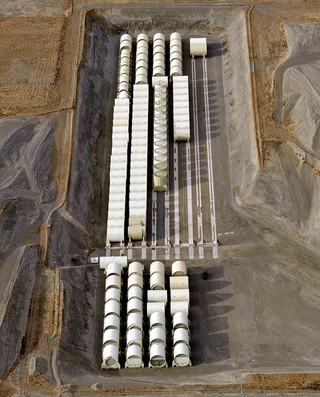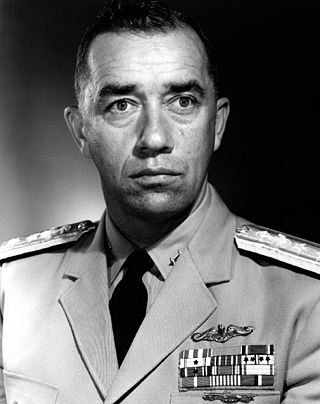
United States naval reactors are nuclear reactors used by the United States Navy aboard certain ships to generate the steam used to produce power for propulsion, electric power, catapulting airplanes in aircraft carriers, and a few more minor uses. Such naval nuclear reactors have a complete power plant associated with them. All U.S. Navy submarines and supercarriers built since 1975 are nuclear-powered by such reactors. There are no commissioned conventional (non-nuclear) submarines or aircraft carriers left in the U.S. Navy, since the last conventional carrier, USS Kitty Hawk, was decommissioned in May 2009. The U.S. Navy had nine nuclear-powered cruisers with such reactors also, but they have since been decommissioned. Reactors are designed by a variety of contractors, then developed and tested at one of several government owned and prime contractor-operated facilities: Bettis Atomic Power Laboratory in West Mifflin, Pennsylvania and its associated Naval Reactors Facility in Idaho, and Knolls Atomic Power Laboratory in Niskayuna, New York and its associated Kesselring site in West Milton, New York, all under the management of the office of Naval Reactors. Sometimes there were full-scale nuclear-powered prototype plants built at the Naval Reactors Facility, Kesselring, and Windsor to test the nuclear plants, which were operated for years to train nuclear-qualified sailors.

Hyman G. Rickover was an admiral in the United States Navy. He directed the original development of naval nuclear propulsion and controlled its operations for three decades as director of the U.S. Naval Reactors office. In addition, he oversaw the development of the Shippingport Atomic Power Station, the world's first commercial pressurized water reactor used for generating electricity. Rickover is also one of four people who have been awarded two Congressional Gold Medals.

USS Thresher (SSN-593) was the lead boat of her class of nuclear-powered attack submarines in the United States Navy. She was the U.S. Navy's second submarine to be named after the thresher shark.
The S1C reactor was a prototype naval reactor designed for the United States Navy to provide electricity generation and propulsion on warships. The S1C designation stands for:
The S1W reactor was the first prototype naval reactor used by the United States Navy to prove that the technology could be used for electricity generation and propulsion on submarines.
Bettis Atomic Power Laboratory is a U.S. Government-owned research and development facility in the Pittsburgh suburb of West Mifflin, Pennsylvania, that works exclusively on the design and development of nuclear power for the U.S. Navy. It was one of the leaders in creating the nuclear navy.
A nuclear navy, or nuclear-powered navy, refers to the portion of a navy consisting of naval ships powered by nuclear marine propulsion. The concept was revolutionary for naval warfare when first proposed. Prior to nuclear power, submarines were powered by diesel engines and could only submerge through the use of batteries. In order for these submarines to run their diesel engines and charge their batteries they would have to surface or snorkel. The use of nuclear power allowed these submarines to become true submersibles and unlike their conventional counterparts, they became limited only by crew endurance and supplies.

Vice Admiral William Wohlsen Behrens Jr. was an American naval officer and oceanographer who was instrumental in establishing the National Oceanic and Atmospheric Administration.

Naval Reactors (NR), which administers the Naval Nuclear Propulsion Program, is an umbrella term for the U.S. government office that has comprehensive responsibility for the safe and reliable operation of the United States Navy's nuclear reactors "from womb to tomb." A single entity, it has authority and reporting responsibilities within both the Naval Sea Systems Command and the National Nuclear Security Administration (NA-30). Moreover, the Director of Naval Reactors also serves as a special assistant to the Chief of Naval Operations for Naval Nuclear Propulsion.
The S5W reactor is a nuclear reactor used by the United States Navy to provide electricity generation and propulsion on warships. The S5W designation stands for:

Machinist's mate is a rating in the United States Navy's engineering community.

Kirkland Hogue "Kirk" Donald is a retired Admiral in the United States Navy, who in his last assignment served as the dual-hatted position of Director of Naval Nuclear Propulsion and Deputy Administrator of the National Nuclear Security Administration. Donald previously served as Commander, Submarine Force, U.S. Atlantic Fleet, and Commander, Submarine Allied Command, Atlantic. He retired from active duty on November 2, 2012.

Eugene Parks "Dennis" Wilkinson was a United States Navy officer. He was selected for three historic command assignments. The first, in 1954, was as the first commanding officer of USS Nautilus, the world's first nuclear-powered submarine. The second was as the first commanding officer of USS Long Beach, America's first nuclear surface ship. The third was in 1980 when he was chosen as the first President and CEO of the Institute of Nuclear Power Operations (INPO) from which he retired in 1984.

Gregory Russell Bryant, Sr. is a retired U.S. Navy Rear Admiral.

Steven Angelo White was a four-star admiral who served in the United States Navy from 1948 until 1985. He was the 19th and last Chief of Naval Material.

The United States Navy job rating of electronics technician (ET) is a designation given by the Bureau of Naval Personnel (BUPERS) to enlisted members who satisfactorily complete initial Electronics Technician "A" school training.
The United States Navy Nuclear Propulsion community consists of Naval Officers and Enlisted members who are specially trained to run and maintain the nuclear reactors that power the submarines and aircraft carriers of the United States Navy. Operating more than 80 nuclear-powered ships, the United States Navy is currently the largest naval force in the world.

Vice Admiral Thomas J. Moore was a senior officer in the United States Navy. He retired from active duty on June 19, 2020, after 39 years of service. He currently serves as Vice President of Nuclear Operations at Huntington Ingalls Industries.

A moored training ship (MTS) is a United States Navy nuclear powered submarine that has been converted to a training ship for the Naval Nuclear Power Training Command's Nuclear Power Training Unit (NPTU) at Naval Support Activity Charleston in South Carolina. The NPTU is part of the Navy's Nuclear Power School at Goose Creek, S.C. The Navy uses decommissioned nuclear submarines and converts them to MTSs to train personnel in the operation and maintenance of submarines and their nuclear reactors. The first moored training ship was USS Sam Rayburn (SSBN-635) a James Madison-class fleet ballistic missile submarine, redesignated as (MTS-635) in 1989, followed a year later by USS Daniel Webster (SSBN-626), a Lafayette-class ballistic missile submarine, redesignated as (MTS-626). Conversion of these two boats took place at the Charleston Naval Shipyard and modifications included special mooring arrangements with a mechanism to absorb power generated by the main propulsion shaft.

James Henry Doyle, Jr was a vice admiral of the United States Navy, and the son of Vice Admiral James H. Doyle, USN.
















